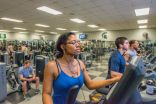(Press-News.org) Defining what makes a star "Sun-like" is as difficult as defining what makes a planet "Earth-like." A solar twin should have a temperature, mass, and spectral type similar to our Sun. We also would expect it to be about 4.5 billion years old. However, it is notoriously difficult to measure a star's age so astronomers usually ignore age when deciding if a star counts as "Sun-like."
A new technique for measuring the age of a star using its spin - gyrochronology - is coming into its own. Today astronomers are presenting the gyrochronological ages of 22 Sun-like stars. Before this, only two Sun-like stars had measured spins and ages.
"We have found stars with properties that are close enough to those of the Sun that we can call them 'solar twins,'" says lead author Jose Dias do Nascimento of the Harvard-Smithsonian Center for Astrophysics (CfA). "With solar twins we can study the past, present, and future of stars like our Sun. Consequently, we can predict how planetary systems like our solar system will be affected by the evolution of their central stars."
To measure a star's spin, astronomers look for changes in its brightness caused by dark spots known as starspots crossing the star's surface. By watching how long it takes for a spot to rotate into view, across the star and out of view again, we learn how fast the star is spinning.
The change in a star's brightness due to starspots is very small, typically a few percent or less. NASA's Kepler spacecraft excels at such exacting brightness measurements. Using Kepler, do Nascimento and his colleagues found that the Sun-like stars in their study spin once every 21 days on average, compared to the 25-day rotation period of our Sun at its equator.
Younger stars spin faster than older ones because stars slow down as they age, much like humans. As a result, a star's rotation can be used like a clock to derive its age. Since most of the stars the team studied spin slightly faster than our sun, they tend to be younger too.
This work expands on previous research done by CfA astronomer (and co-author on the new study) Soren Meibom. Meibom and his collaborators measured the rotation rates for stars in a 1-billion-year-old cluster called NGC 6811. Since the stars had a known age, astronomers could use them to calibrate the gyrochronology "clock." The new research led by do Nascimento examines free-floating "field" stars that are not members of a cluster.
Since stars and planets form together at the same time, by learning a star's age we learn the age of its planets. And since it takes time for life to develop and evolve, knowing the ages of planet-hosting stars could help narrow down the best targets to search for signs of alien life. Although none of the 22 stars in the new study are known to have planets, this work represents an important step in the hunt for Sun-like stars that could host Earth-like planets.
INFORMATION:
Sun-like stars reveal their ages
2014-07-10
ELSE PRESS RELEASES FROM THIS DATE:
World interest in research work on the benefits of the Okra plant
2014-07-10
Estonian-born Katerina Alba's research at the University of Huddersfield could help to improve the quality of some of the most popular emulsion-based food products – such as butter, mayonnaise, yoghurt and fruit drinks – and she is starting to gain an international profile for her work.
Katerina gained her MSc degree in nutrition and food science at the University and now she has embarked on research for a PhD. Working with her supervisor, Dr Vassilis Kontogiorgos, she is investigating the potential of carbohydrates extracted from the pods of the okra plant. They can ...
Understanding consciousness
2014-07-10
EVANSTON, Ill. --- Why does a relentless stream of subjective experiences normally fill your mind? Maybe that's just one of those mysteries that will always elude us.
Yet, research from Northwestern University suggests that consciousness lies well within the realm of scientific inquiry -- as impossible as that may currently seem. Although scientists have yet to agree on an objective measure to index consciousness, progress has been made with this agenda in several labs around the world.
"The debate about the neural basis of consciousness rages because there is no widely ...
Bacterial colonization prior to catching the flu may protect against severe illness
2014-07-10
Many studies have shown that more severe illness and even death are likely to result if you develop a secondary respiratory infection after developing influenza. Now, however, a team of researchers based at The Wistar Institute has determined that if you reverse the order of infection, the bacteria Streptococcus pneumoniae (often called pneumococcus) may actually protect against a bad case of the flu.
The researchers discovered that the bacterial protein pneumolysin, which is described as a bacterial virulence factor, might protect macrophages—a type of immune system ...
What's a concussion? Review identifies four evidence-based indicators
2014-07-10
(July 10, 2014) – A research review identifying the clinical indicators most strongly associated with concussion is an important first step in the process of developing evidence-based guidelines for concussion diagnosis, prognosis, and treatment, according to a new report published by Neurosurgery, official journal of the Congress of Neurological Surgeons. The journal is published by Lippincott Williams & Wilkins, a part of Wolters Kluwer Health.
Based on analysis of the best available research data, a multidisciplinary panel of experts has identified a set of four ...
For children with pacemakers, 'self-competence' affects quality of life
2014-07-10
July 10,2014 – For children and teens living with a cardiac pacemaker, a low sense of self-competence seems to contribute to decreased quality of life, reports a study in the July Journal of Developmental & Behavioral Pediatrics, the official journal of the Society for Developmental and Behavioral Pediatrics. The journal is published by Lippincott Williams & Wilkins, a part of Wolters Kluwer Health.
"Self-competence may function as a protective factor against lower health-related quality of life in children with pacemakers," according to the study by Ana M. Gutierrez-Colina ...
Merging galaxies and droplets of starbirth
2014-07-10
The Universe is filled with objects springing to life, evolving and dying explosive deaths. This new image from the NASA/ESA Hubble Space Telescope captures a snapshot of some of this cosmic movement. Embedded within the egg-shaped blue ring at the centre of the frame are two galaxies. These galaxies have been found to be merging into one and a "chain" of young stellar superclusters are seen winding around the galaxies' nuclei.
At the centre of this image lie two elliptical galaxies, part of a galaxy cluster known as[HGO2008]SDSS J1531+3414, which have strayed into each ...
Diving for pearls with the Hubble Space Telescope
2014-07-10
Stars forming like a string of blue pearls along two elliptical galaxies could be the result of a galactic merger, according to an international team of astronomers. The structure could reveal rare insights about elliptical galaxies.
Scientists from Rochester Institute of Technology helped analyze data from the Hubble Space Telescope showing elliptical galaxies coalescing at the core of a dense galaxy cluster. The study is part of a program sponsored by the Hubble Space Telescope—an international cooperation between NASA and the European Space Agency—to look inside 23 ...
Want a higher GPA in college? Join a gym
2014-07-10
EAST LANSING, Mich. – For those students looking to bump up their grade point averages during college, the answer may not be spending more time in a library or study hall, but in a gym.
New Michigan State University research shows that students who were members of the recreational sports and fitness centers on MSU's campus during their freshman and sophomore years had higher GPAs than those who weren't.
The research also indicated that students with memberships stayed in school longer. An increase of 3.5 percent in two-year retention rates was seen among this group.
"That ...
Feedback control could be key to robust conservation management
2014-07-10
Mathematical algorithms used to control everyday household items such as washing machines could hold the key to winning the fight for conservation, a new study has claimed.
As part of an EPSRC research project, a team of UK scientists and mathematicians, including those from the University of Exeter, have shown how techniques commonly used in control engineering, could be replicated in the natural world to help restock declining populations.
The innovative new study suggests 'integral control' - in essence a built-in feedback control mechanism to maintain a constant – ...
Wildfires dot central Russia's landscape
2014-07-10
This natural-color satellite image was collected by the Moderate Resolution Imaging Spectroradiometer (MODIS) aboard the Aqua satellite on July 10, 2014. Each hot spot, which appears as a red mark, is an area where the thermal detectors on the MODIS instrument recognized temperatures higher than background. When accompanied by plumes of smoke, as in this image, such hot spots are diagnostic for fire.
This area of Russia is extremely remote with little danger coming directly from the fires, although the smoke released by any type of fire (forest, brush, crop, structure, ...





